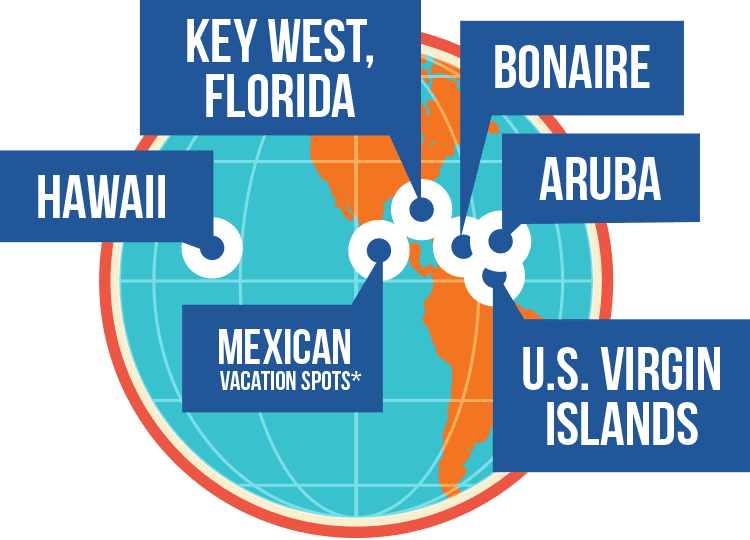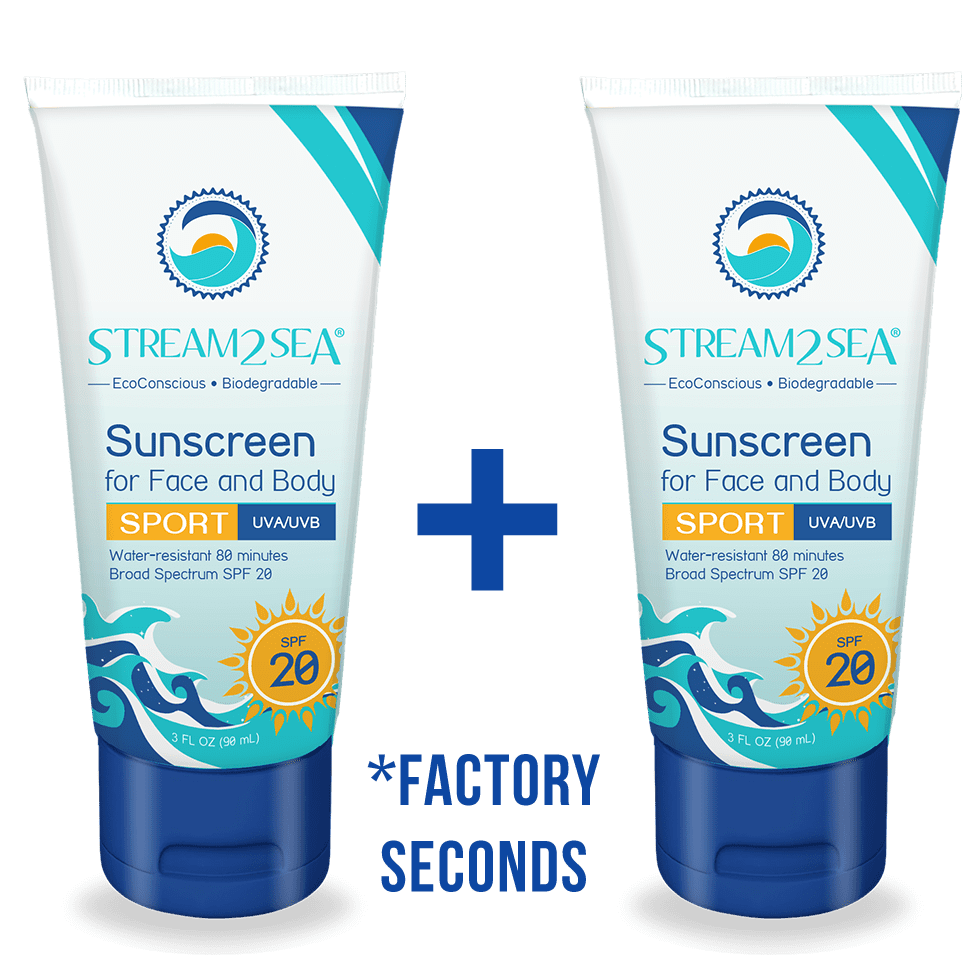No products in the cart
Sunscreen Bans - Travel EcoConsciously!
TAKE ACTION FOR OUR REEFS: Ask Florida’s governor to ban the ban on toxic sunscreen ingredients!
Read our letter to the governor below.
Dear Governor DeSantis,
It’s a pretty basic expectation: Sunscreen ingredients should be generally recognized as safe and effective by the U.S. Food and Drug Administration.
Ironically, you’re now being asked to sign legislation that would make it illegal for local governments to ban ingredients that don’t meet that fundamental expectation.
It gets cloudy fast but the issue in Key West and Miami Beach is coral reefs. Common sunscreen ingredients have been shown to kill coral larva at concentrations as low as 62 parts per trillion, or about one drop in 6.5 Olympic-sized swimming pools. Three sites tested by NOAA staff in Florida showed concentrations far in excess of that level:
- Bahia Honda (Florida Keys), oxybenzone levels of 4,474 parts per trillion on Aug. 9, 2015
- Fort Zachary Taylor (Key West), oxybenzone levels of 8,114 ppt on March 18, 2017
- Miami Beach, 15,425 ppt on Aug. 11, 2015.
As these data show, concentrations of oxybenzone skyrocket at the most popular beaches where swimmers congregate in larger numbers.
We’re not sure why a Republican legislature would intentionally override local governments who are working to protect their livelihoods but that’s exactly what Senate Bill 172 and House Bill 113 would do. Senator Rob Bradley, an attorney representing largely land-locked constituents, has said that “the scientific community does not support” claims that these ingredients are killing coral reefs.
We beg to differ, as do experts from NOAA, the National Parks Service and the Florida Department of Environment Protection.
Even mainstream medical doctors and dermatologists — most concerned about skin cancer rates increasing — recommend avoiding these chemicals.
- The international medical journal Lancet supports the Hawaiian ban on chemical sunscreens saying “there are many safe alternatives that people can use until this uncertainty is resolved.”
- The Journal of the American Academy of Dermatologists reviews scientific reports on the adverse environmental impacts of oxybenzone and concludes that “practicing photoprotection… and applying sunscreens with inorganic filters (titanium dioxide and zinc oxide) are an alternate means of protecting oneself from UV radiation.”
- Skinmed, a peer-reviewed journal for international dermatologists, reports that “There is strong evidence that some sunscreen ingredients, especially oxybenzone, are harmful to corals if the concentration in water is high.”
- Plastic Surgery Nursing notes “It has also been shown that there are more effective UV filters, such as zinc oxide and titanium dioxide, which do not carry the same environmental and health concerns as oxybenzone and octinoxate.”
And that’s all before you look at the recent FDA actions requesting major manufacturers to provide safety data for the first time in 40 years on sunscreen ingredients originally approved in the 1970s – safety data that industry has been unwilling or unable to provide to date.
The only ingredients the FDA still recognizes as safe and effective are zinc oxide and titanium dioxide which do not impact coral reefs or absorb into bloodstreams as their chemical counterparts do
While there is no proven cause-and-effect relationship between common sunscreen chemicals and adverse impacts, the FDA has confirmed that a single application of sunscreen containing oxybenzone resulted in concentrations more than 360 times its safety threshold.
At least nine of the sunscreen ingredients being reviewed are known endocrine disruptors that produce adverse developmental, reproductive, neurological, and immune effects in both humans and wildlife. Scientists are documenting a wide variety of impacts in humans, from infertility in men to endometriosis among women, and even an increased risk for potentially lethal birth defects. The increased use of chemical sunscreens may even help explain why unexplained infertility has become so prevalent.
And even as more and more people apply more and more sunscreen, more people are diagnosed with skin cancer each year in the U.S. than all other cancers combined and at least one in five Americans will develop skin cancer by the age of 70.
We absolutely agree that protecting skin from UV rays is critically important. The issue here is does the State of Florida make it illegal for local governments to ban ingredients that scientists, researchers and medical professionals agree should be avoided?
It makes no sense to us, we hope you agree.
Sincerely,
Autumn Blum
Founder and CEO
Stream2Sea



How it all started:
“We were on a live-aboard, diving a spectacular reef when I noticed a sunscreen oil slick coming off a group of snorkelers,” recalls Autumn Blum, an award-winning cosmetic chemist, avid diver, and our founder. “I knew then that I had to start making products that were truly safe for the oceans I love.”
The reason why so many sunscreens are loaded with marine toxic ingredients is that each ingredient covers only a tiny spectrum of sunlight that causes sunburn and ages skin—it takes several to cover a broad spectrum of UV rays.
Oxybenzone and octinoxate, along with other chemicals on the HEL list, are being banned by many coastal communities. These have been shown in studies to damage coral by causing them to expel their symbiotic algae — a process called bleaching. The chemicals also impact free-swimming coral larvae, preventing the reef from replicating. In tourist-heavy bays and inlets, sunscreen pollutes the water to a large enough extent to damage reefs, according to 2016 research published in the journal Archives of Environmental Contamination and Toxicology.



Palau Sunscreen Ban
Palau’s legislation not only bans the sale of toxic products, but also enforces fines for vendors who continue to sell toxic products.
The Palau bill goes beyond the two chemicals Hawaii has banned all ingredients shown by the prestigious Haereticus Environmental Laboratory to be toxic to our reefs.
Bonaire Sunscreen Ban
Hawaii Sunscreen Ban
The Hawaiian legislature passed rules banning oxybenzone in sunscreens to protect their coral reefs! It will make Hawaii the first state in the country to pass such a law in May 2018 and it will go into effect January 2021.
USVI Sunscreen Ban
US Virgin Islands voted on June 25, 2019 to ban common chemical sunscreen ingredients that can damage coral reefs. The new law, passed unanimously in the U.S. Virgin Islands’ legislature, targets oxybenzone, octocrylene, and octinoxate, three UV-blocking chemicals found in most mainstream commercial sunscreen products in the United States. Studies have shown they harm coral and other marine ecosystems. Imports of sunscreens containing the chemicals will be outlawed as of Sept. 30, 2019; the ban on their distribution, sale, possession and use will take effect March 30, 2020.
Key West Sunscreen Ban
The City of Key West met in January to discuss a ban on the use of sunscreens that contain the chemicals Oxybenzone and Octinoxate, two commonly used ingredients known to be lethal to coral larva. This important vote inspired me to write in support of the ban. While the measure passed 7-0 in January, the city council was required to confirm that vote…
And we are so overjoyed to know that the recent vote to ban Octinoxate and Oxybenzone in Key West HAS PASSED. Beginning in January 2021, Key West will ban such sunscreens from sale within city limits.
Aruba Sunscreen Ban
Aruba announced the ban on sunscreens containing oxybenzone in full effect in 2020, because it is dangerous for corals, marine life and the human skin which is absorbed by the body. Incidentally, it also bans single-use plastic! Way to go Aruba.
What’s Next? Upcoming Legislation & Progress
Other highlights of the proposal include new sunscreen label requirements that will list the active ingredients on the front of the package, additional and “rigorous assessment” of all active chemical sunscreen ingredients on the market, and a cap on SPF at 60+. The FDA will also be seeking out industry experts, such as dermatologists and cosmetic chemists, who might be able to provide more information on those 12 ingredients.
We’ve been making big waves about this sunscreen ban in the news. I had the privilege to go on-air with RTAmerica and talk about the importance of this sunscreen ban and why it means so much to our planet. You can watch that video clip by clicking HERE. Our VP, Mike Malterre also made an appearance on The Key West Perspective Podcast to discuss the ban, harmful chemicals, and what our company is doing to protect what we love — the reefs! You can listen to that episode by clicking HERE.
“Of the 16 different active ingredients in sunscreens currently on the market, the FDA deemed only two as being safe to use: zinc oxide and titanium dioxide.“
The absolute best way to protect yourself from the dangers of the sun are to avoid the sun, seek shade, wear protective clothing, and use ocean-friendly, reef-safe sunscreen. We are so proud of our ocean-friendly products — they have been third party tested and proven safe for your body and the water you’re in.
As reported by Dr. Craig Downs of Haereticus Environmental Laboratory, “Recently, oxybenzone and octinoxate in sunscreen products have been banned in Hawaii and Key West, as well as by countries such as Palau, Bonaire, and Aruba. These chemicals were banned because they posed a threat to the survival of coral reefs and other marine wildlife, but also because of the awareness that these chemicals could have adverse impacts on public health.”
Together we are doing better.
Thank you for exploring our planet eco-consciously!
Sport Sunscreen SPF 30 (Factory Seconds)
- Pampers all skin types (including sensitive skin) with our potent organic antioxidant blend of Green Tea, Tulsi, Wakame and Olive Leaf
- 100% Mineral Actives: 8.8% (Non-Nano) Titanium Dioxide
- Non-greasy and won’t burn your eyes
- NO Oxybenzone, Avobenzone, Octinoxate and Octocrylene
- Hawaii safe sunscreen - Contains no banned ingredients
Sunscreen for Face and Body SPF 20 (Factory Seconds)
- Pampers all skin types (including sensitive skin) with our potent organic antioxidant blend of Green Tea, Tulsi, Wakame and Olive Leaf
- 100% Mineral Actives: 6.6% (Non-Nano) Titanium Dioxide
- Non-greasy and won’t burn your eyes
- NO Oxybenzone, Avobenzone, Octinoxate and Octocrylene
- Hawaii safe sunscreen - Contains no banned ingredients
Every Day Mineral Sunscreen 4 Kids (Factory Seconds)
- SPF45 Broad Spectrum UVA/UVB
- 80 mins Water-Resistant
- Sheer, Non-Greasy, Lightweight
- Pediatrician-Approved With Soothing Chamomile & Calendula
- Hawaii safe sunscreen - Contains no banned ingredients
- NO SLS, Parabens, Preservatives & Artificial Fragrances
Every Day Active Mineral Sunscreen (Factory Seconds)
- SPF45 Broad Spectrum UVA/UVB
- 80 mins Water-Resistant
- Non-Greasy, Lightweight, Sheer Protection Every Day
- Hawaii safe sunscreen - Contains no banned ingredients
- NO SLS, Parabens, Preservatives & Artificial Fragrances
Sport Sunscreen SPF 30 (Travel)
- Pampers all skin types (including sensitive skin) with our potent organic antioxidant blend of Green Tea, Tulsi, Wakame and Olive Leaf
- 100% Mineral Actives: 8.8% (Non-Nano) Titanium Dioxide
- Non-greasy and won’t burn your eyes
- NO Oxybenzone, Avobenzone, Octinoxate and Octocrylene
- Hawaii safe sunscreen - Contains no banned ingredients




